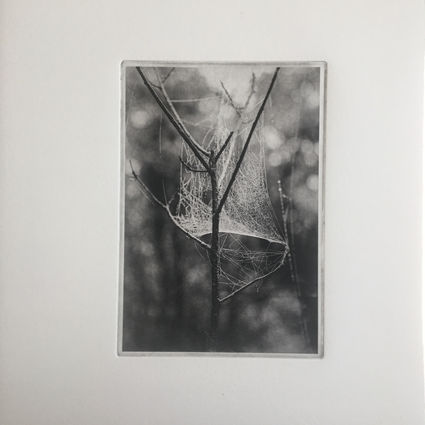
Fine Art Prints
Limited Edition Print Releases
Selected images from a growing archive are handprinted as analogue graphic works.
During each season certain prints will be released and available to purchase.
Contact me for the latest release.
Visit my P R I N T S H O P where you can see what editions can be ordered directly.
TIME RESPONSES :
The organic process of growing a wide body of work over time - draws on my interest and discovery of new motifs. Adding to each series at intervals on a cyclical seasonal basis, means my work and ideas never become static, but constantly evolving.
Visit Grafik I Väst Galleri in Gothenburg to see a stock of prints. Grafik I Väst, Storgatan 20.
PORTFOLIOS
-
Underland Series 2019 / 2020
-
Web Land Series 2018 / 2020 archive
-
Botanical Series 2019 / 2021
-
Mid Winter Series 2019 / 2021
-
La Gomera, Finca Series 2019
-
Göta Älv 2021 / 2022
-
Playing with Time Series 2021
-
Elements of the Long Season I, II, III ( Pigment Prints )
-
Elements of the Long Season IV -IIIV 2022 ( 20:20 International Print Exchange )
-
Elements of the Long Season VI 2023 - Artist Print sent to Etch Ink Art Gallery - Athens Printmaking Center

PHOTOPOLYMER INTAGLIO PRINTING AND TRADITIONAL PHOTOGRAVURE
Traditional Photogravure comes from an old intaglio ´photo-mechanical´ printmaking process and was mainly produced in the specialist printing industry on Rotogravure Press, producing a photographic image on paper.
The Photogravure process draws inspiration from 19th-century photography techniques, particularly Photographic Engraving pioneered by Henry Fox Talbot and further developed by Czech painter Karel Klíč in 1878. Originating from Nicéphore Niépce's Heliography method, it has evolved into today's traditional, Photogravure process. Traditional Photogravure involves creating a textured surface on a copper plate through a complex exposure of a film positive on light-sensitive gelatin, resulting in a permanently etched substrate. This plate, reminiscent of a grainy photographic print, allows for high-detail reproduction. An alternative, the Photopolymer Intaglio method simplifies this process, offering a safer, low-toxic approach. Artists use a contact print transfer onto a pre-prepared substrate of metal coated with photosensitive emulsion. UV light exposure through a positive transparent film facilitates image transfer, followed by development in water and curing for multiple prints. Adapted from commercial planographic printing, it gained popularity in the '80s and has evolved into a safer method for artists over the last two decades. This method, chosen for its safety and environmental consciousness, allowed me to transition from digital captures to hands-on analogue printmaking. My initial exposure to this technique occurred during my time at Art Collage and as a printmaking tutor at the Bluecoat Art Centre, Liverpool. Recently, I revisited this safer alternative during a workshop with Henrik Bœgh in Copenhagen in October 2019. Through experimentation and adaptation, my goal is to advance non-toxic methods for environmental protection and the well-being of fellow printmakers in prints studios practice in.
PROCESS
Photopolymer Intaglio Prints
Each print is hand-pulled on high-quality, heavyweight paper—most often Hahnemühle German Etching. Every image begins as a digital photograph taken from my seasonal studies in nature. After converting the image to greyscale, it’s printed onto a transparent film.
This film is placed over a light-sensitive photopolymer plate (Toyobo KM73) and exposed under UV light in a vacuum frame. The exposure transfers the image onto the plate, which is then developed in a water bath to bring out the etched texture. After a final UV hardening, the plate is ready to ink and print.
PRINTING
I print all my plates by hand in the traditional Intaglio way. Each unique plate is individually hand inked and wiped to sensitively pick up fine photographic details from the delicate etched surface. They are run through a traditional flat bed etching press ( pressed under a heavy steel roller) and sandwiched between dampened etching paper and fine woollen blankets (felts). Each time I print, this method produces a unique set of photographic printed works, sometimes with quite unexpected results. The detail in the tonal values are which I find so particularly interesting with this method of working. My eye and hand intricately work at each stage of the process, to translate its own visual language with a certain subtle characteristic of definition and depth of tone.
ORIGINAL MULTIPLES
Every print I make from a single plate is intentionally unique. Because I hand-ink each image, they naturally vary—some are strong monochromes, others softer duotones—depending on what I want to bring forward in the photograph.
“Original Multiples” simply means a set of prints that share a theme but are not identical.
I create most of my work in series based on my own photographs, building a varied portfolio.
I’m also exploring new printmaking methods, including safe-ground copper and zinc etching, photopolymer, carborundum for textured colour, and tetrapack collotypes. Experiments are ongoing; I’ll share updates on Instagram as they develop.
Please email to peruse the archive list of works.
PROJECT OFFER
I'm happy to be commissioned to work on your own art or photo art project. I look forward to hearing from photographers and artists to re produce their works through an alternative photographic technique. I tailor make prints to your specific requirements in budget.
Individual Quotes & Examples.
Contact direct to discuss your unique project idea.














